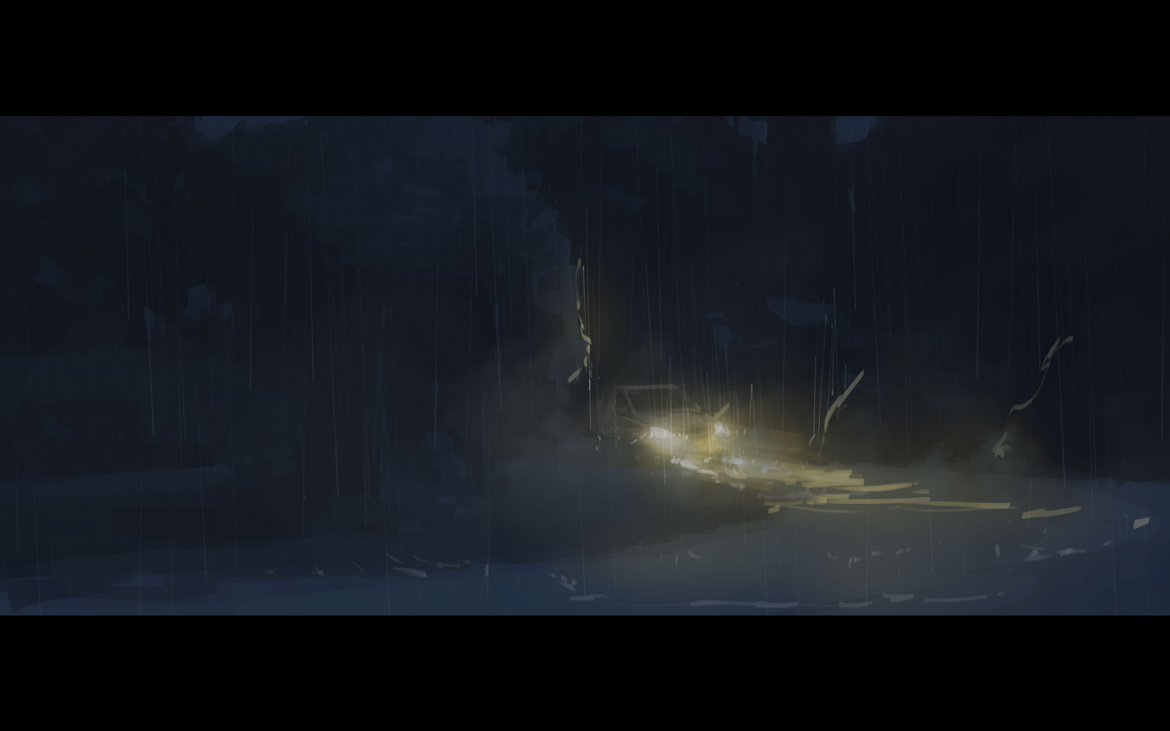Inspiration: Motion Pictures
(Version française plus bas)
From the very beginning, we wanted, Nico and I, the game to have a very “cinematic” look and feel. That’s why we chose a wide screen format for the “main stage”, and that’s how we ended with a very “de Palma”-like split screen for the dialog sequences. As for the story… Well, our main inspiration also came from some famous directors and some maybe-not-as-famous movies.
First and foremost, let’s talk about Polanski. If I had to chose between all the “new holywood” directors, I would always chose Polanski over any Scorcese or Coppola. What I admire most about his work is his way to infuse some weirdness by little touch in horror movies, creating something that’s closer to Borges’s “Magical Realism” than pure fantasy.
One of the things I borrowed from Polanski is his inclination to always keep some lightness and humor even in his darkest productions. I didn’t want Along the Edge to be all dark, gloomy and broody, so I looked up to Polanski to try to infuse some dry humor throughout the game.
Another main influence in the themes of the game is Claude Chabrol and his vitriolic depiction of rural France (the fact that Chabrol was born in Limousin may be a factor too).
As for the lesser known influences, there’s, of course, Julio Medem and his cinema of the ellipsis, and, in particular, his 2007 movie Caótica Ana. What I really enjoyed in this picture was the evolution of the main character, Ana, during the movie, and the way she loses her innocence while she goes deeper and deeper into the realms of the strange and the mystical.
Of course, you may not go “deeper and deeper into the realms of the strange and themystical” during your play through of the game, but further and further into the skepticism instead. For that side of the story, we took some notes from Rodrigo Cortés and his movie Red Lights (2012). Even if the twist ending may divide the viewers, the first half of the movie was very enjoyable, with its team of scientists specialized into debunking supernatural phenomena. The quirky and “tongue in cheek” way they look at these so-called mediums and clairvoyants was our main inspiration for Daphné’s attitude if you choose a scientist state of mind during your play through.
Of course, this list is not exhaustive, but we wanted you to take a peak at what we like and admire, and how it translates into our own creative outlet. I guess you know what to do next… (hint: it may include a web-streaming subscription or a DVD player).
Depuis le début de la production, nous voulions, Nico et moi, que le jeu ait une dimension et un look vraiment “cinématographique”.
C’est pour cela que nous avons choisi le format “wide screen” pour dépeindre le théâtre de l’action, et c’est ainsi que nous nous sommes retrouvés à mettre en scène les dialogues avec un écran splitté à la “de Palma”. Quant à l’histoire… Nos sources d’inspiration principales sont également quelques réalisateurs célèbres et quelques films peut-être un peu moins célèbres.
Tout d’abord, parlons un peu de Polanski. Si je devais choisir entre tous les réalisateurs du “nouvel Holywood”, ce serait, sans hésitation, Polanski, au détriment de n’importe quel Scorcese ou autre Coppola. Ce que j’admire le plus dans son travail, c’est sa façon d’intégrer l’étrangeté par petites touches dans son cinéma d’horreur, se rapprochant plus du “Réalisme Magique” d’un Borges que du cinéma fantastique pur et dur.
Un autre aspect que j’ai essayé d’emprunter à Polanski, c’est sa propension à toujours conserver une certaine légèreté et un certain humour, même dans ses oeuvres les plus sombres. Je voulais à tout prix éviter qu’Along the Edge soit entièrement noir, glauque et aride, aussi, j’ai tenté d’insuffler des touches d’humour un peu pince-sans-rire dans mes personnages, à la manière de Polanski.
Une autre influence notable sur les thèmes abordés dans le jeu reste Claude Chabrol, et sa peinture au vitriol de la France rurale (le fait qu’il soit né en Limousin y est peut-être pour quelque chose).
Pour ce qui est des influences moins connues, il y a, bien sûr, Julio Medem, et son cinéma de l’ellipse, en particulier son oeuvre de 2007, Caótica Ana. Ce qui m’a particulièrement interpelé dans ce film est l’évolution du personnage principal, Ana, et la façon dont elle perd peu a peu son innocence à mesure qu’elle s’enfonce de plus en plus dans le royaume de l’étrange et de la mystique.
Bien sûr, peut-être que, durant votre partie, vous ne vous aventurerez pas “de plus en plus dans le royaume de l’étrange et de la mystique”, mais, au contraire, de plus en plus loin dans le scepticisme. Pour cette facette de l’histoire, nous avons pris des notes du côté de Rodrigo Cortés et de son film Red Lights (2012). Si son “twist” final peut diviser, la première moitié du film est tout à fait excellente, avec son équipe de scientifiques spécialisés dans le démantèlement de phénomènes paranormaux. Leur attitude désinvolte et arrongante face aux soi-disant médiums et autres clairvoyants a été notre référence principale si vous choississez la voie de la science pendant votre partie.
Bien sûr, cette liste n’est pas exhaustive, mais nous voulions partager un petit panel de ce que nous aimons et admirons et la façon dont nous essayons de le traduire dans notre production créative. J’imagine que vous savez ce qu’il vous reste à faire…
IMDB links :
- Roman Polanski — http://www.imdb.com/name/nm0000591/
- Claude Chabrol — http://www.imdb.com/name/nm0001031
- Julio Medem – Caótica Ana — http://www.imdb.com/title/tt0456340/
- Rodrigo Cortés – Red lights — http://www.imdb.com/title/tt1748179/
